Goetta Recipe (Cincinnati Sausage)
This post may contain affiliate links. See my disclosure policy.
These famous German-influenced sausage grain patties known as Goetta from the Greater Cincinnati area have a fantastic flavor and are an absolutely delicious addition to your breakfast! This authentic homemade Goetta recipe captures the flavor and texture that you know and love. Make a double batch while you’re at it because it freezes well!
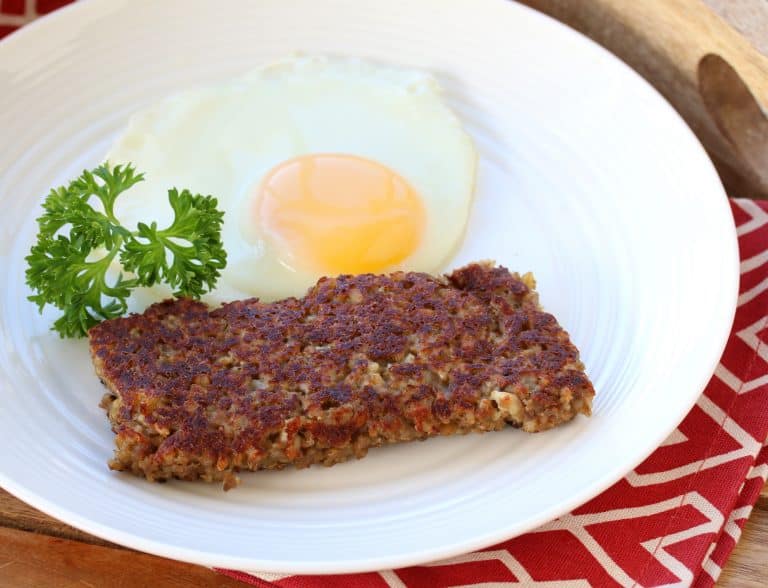
What is Goetta?
You may not have heard of goetta, but it’s famous. At least it is in Cincinnati where it’s practically a staple ingredient. So much so the people of the Greater Cincinnati area consume over 1 million pounds of it ever year. That’s 450 metric tons of goetta!
What’s more, there’s even an annual goetta festival, “Glier’s Goettafest”, that’s held every August near Newport, Kentucky and features goetta served every way imaginable. Music, dancing and other entertainment adds to the occasion of celebrating this beloved food as well as the German-American heritage of the Greater Cincinnati area.
So what is goetta (pronounced “getta”)? Goetta is a mixture made out of meat, steel-cut oats, onions and spices that is formed into sausages patties, fried, and eaten for breakfast. The dish is of German origin and the name is a derivative of the German words Grötte or Grütze (depending on the region), which translates to “groats,” but this dish is not known as Goetta in Germany.

Where Did Goetta Originate?
The concept goetta is similar to Pennsylvania Dutch scrapple, Polish kishka and Scottish haggis in that, all these originally being peasant dishes, it was a way to make the most of every part of the animal – to use up the scraps – and to make them stretch to feed the most people possible.
In the case of goetta, it was brought to the Cincinnati area over a century ago by German immigrants from northern Germany. While the version in north Germany would have been made more commonly with buckwheat, barley or rye (the grains most prolifically grown in that area), oats were substituted once the immigrants reached Cincinnati (which is the more common crop in that area). Also, the original, peasant German version would have included more animal organ parts whereas goetta is made with the muscle meat only (when the German immigrants reached the United States they found that pork here was much cheaper).
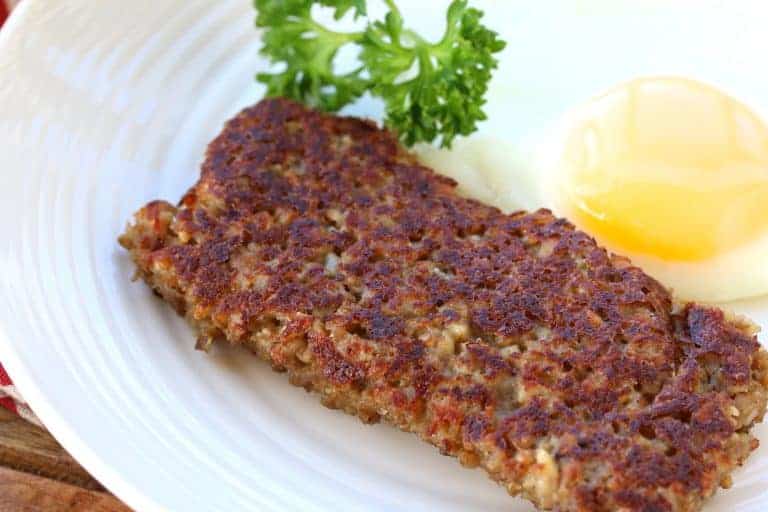
Goetta Ingredients
The primary ingredients in this goetta recipe are steel-cut oats, beef, pork, onion and garlic. The oats are simmered in beef broth for added flavor and a special selection of herbs and spices are added. There are several key seasonings that are essential to achieving the “old world” flavor that many German meats and sausages are associated with: Mace, marjoram, coriander, white pepper, cloves and ginger. Don’t omit or substitute any of these. Include all of them and once you’ve tasted the final result you’ll be very happy you did!
Serving Recommendations
Goetta’s a classic breakfast food and is usually serve with eggs, toast, fruit, etc. But you’ll also find it served in any number of other ways in Cincinnati and throughout the region: Crumbled onto nachos, pizza, in quesadillas, tacos, burritos, and sandwiches, baked in casseroles, mac and cheese and frittatas, piled onto loaded potato skins, or even goetta fried rice. In short, goetta fans are pretty serious about this stuff and once you’ve tried it you’ll understand why!

How to Cook Goetta
Yes, this can be a point of frustration. You’ll find forums online of people venting and lamenting and asking for help on how to fry goetta so that it doesn’t completely fall apart in the pan.
I’ll say it right now, it is challenging keeping the patties together when you fry them and that’s just the nature of goetta. Goetta is not a firm sausage patty. It’s a fairly soft and loose patty with a browned and crispy exterior. And reducing the amount of water won’t help, neither will adding things like bread crumbs or eggs. That said, there is a way to keep goetta from falling apart and to ensure the patties keep shape.
Pro Tips
There are 5 keys to cooking goetta so that it holds together, keeps it shape, and browns nicely:
- The first key to helping them keep shape is slicing them thickly (at least 1/2 inch thick).
- The second key is to avoid using any oil whatsoever. Oil will only make it soggier and fall apart more. Just use a dry non-stick pan over medium-high heat. Again, no oil.
- The third key is waiting until the pan is preheated over medium heat and then letting them fry long enough on both sides to firm them up a bit. Fry them for 5-8 minutes on the first side until the top changes color (it’s very light/almost white to begin with and will become a little yellower in color,) and the bottom is fully browned. Then carefully flip it and brown the other side (this side will cook faster).
- The fourth key is to avoid pushing or pressing down on the patties.
- The fifth key is to leave it alone while it’s frying. Don’t push down on it or try to move it before it’s fully browned on the bottom or it will stick. Also, do not to overcrowd the pan.
Keep in mind, after implementing each of these tips the patties still won’t be “firm” – they’re not supposed to be. Ignore the imperfections in shape or appearance, just shovel the goetta onto your fork and into your mouth and then chew it with complete satisfaction. Equipped with these 5 Keys To Goetta Success, it’s time to move on to the goetta recipe!
Goetta Recipe
Let’s get started!
Place the broth, oats, water, salt, bay leaves and marjoram in a large pot. Bring it to a boil then reduce the heat to low, cover, and gently simmer for 90 minutes, stirring occasionally, until it’s soft and the liquid is absorbed. Discard the bay leaves.
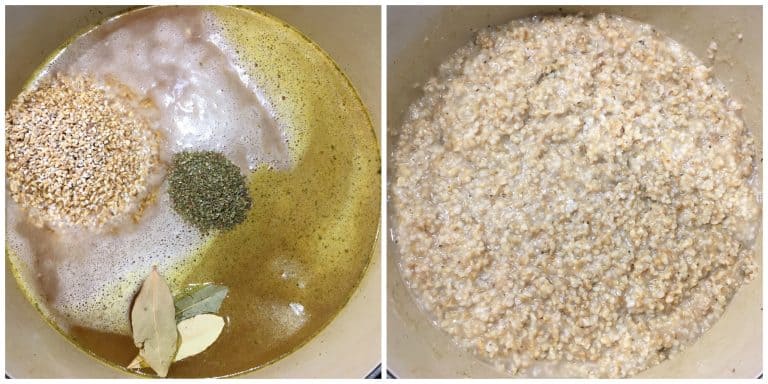
Add the meat, onions, garlic and spices. Return to a boil then reduce to low, cover and cook for another hour, stirring occasionally. If the liquid has not all been absorbed, remove the lid and continue to cook uncovered, stirring occasionally until the mixture has thickened.
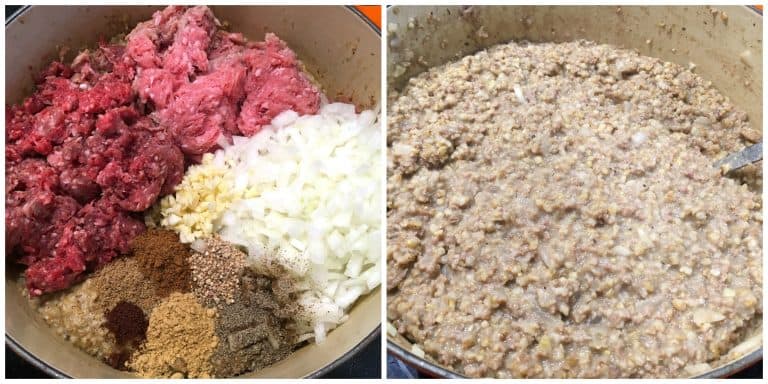
Pour and press the mixture into 2 (9×5) greased loaf pans and let cool completely. Cover with plastic wrap and refrigerate overnight.
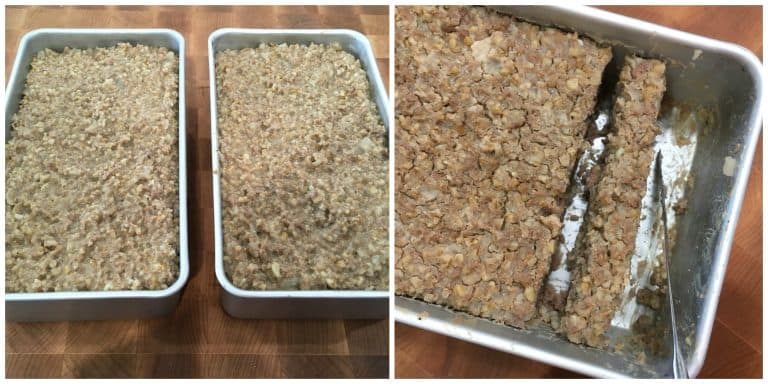
To serve, cut into thick slices, at least 1/2 inch (otherwise they’ll fall apart), and fry them in batches in a non-stick pan without any oil. Fry them on both sides for 4-5 minutes or until nicely browned. Serve immediately.
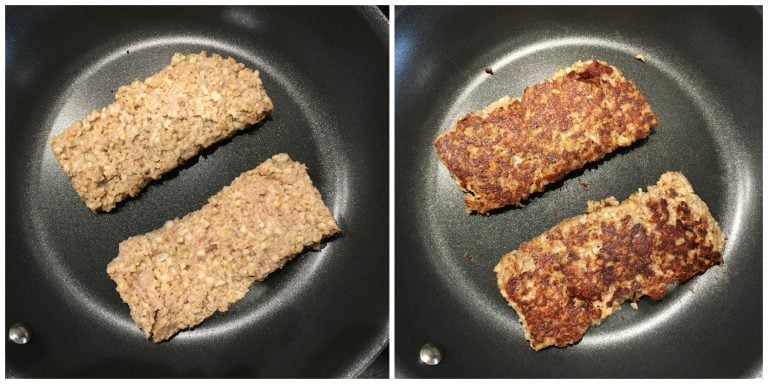
Enjoy!
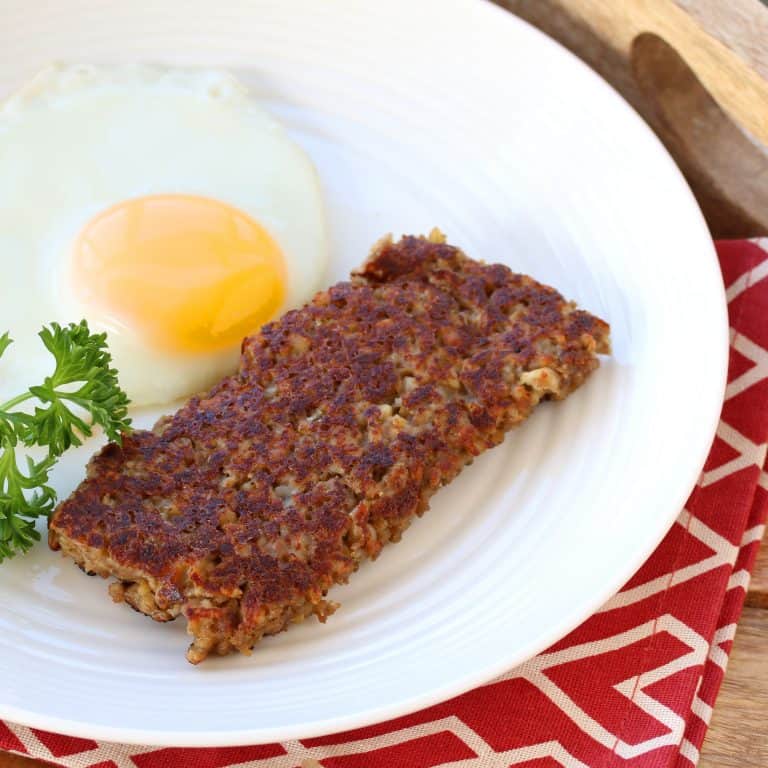
For more delicious homemade sausage recipes be sure to try my:
- Homemade Breakfast Sausage (Links or Patties)
- Italian Sausage Recipe
- Homemade Mexican Chorizo
- German Bratwurst
- British Bangers
- Smoked Cheddar Sausages
Save This Recipe
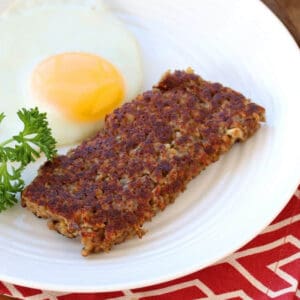
Goetta Recipe (Cincinnati Sausage)
Ingredients
- 2 1/2 cups steel-cut oats (aka pinhead oats)
- 4 cups beef broth
- 4 cups water
- 3 teaspoons sea salt
- 3 bay leaves
- 1 1/2 teaspoons dried marjoram
- 1 pound ground beef
- 1 pound ground pork
- 1 large yellow onion , finely chopped
- 5 cloves garlic, minced
- 1 teaspoon ground ginger
- 1 teaspoon ground mace
- 1/2 teaspoon freshly ground black pepper
- 1/2 teaspoon freshly ground white pepper
- 1/2 teaspoon ground coriander
- 1/4 teaspoon ground cloves
Instructions
- Place the broth, oats, water, salt, bay leaves and marjoram in a large pot. Bring it to a boil then reduce the heat to low, cover, and gently simmer for 90 minutes, stirring occasionally, until it's soft and the liquid is absorbed. Discard the bay leaves. Add the meat, onions, garlic and spices. Return to a boil then reduce to low, cover and cook for another hour, stirring occasionally. If the liquid has not all been absorbed, remove the lid and continue to cook uncovered, stirring occasionally until the mixture has thickened.Pour and press the mixture into 2 (9×5) greased loaf pans and let cool completely. Cover with plastic wrap and refrigerate overnight.
- To serve, cut into thick slices, at least 1/2 inch (otherwise they'll fall apart; I cut them inside the pan, if you invert the whole thing it will be very messy), and fry them in batches in a non-stick pan over medium-high heat without any oil. Again, do not use oil, use a dry, non-stick pan. Fry them on both sides for 4-5 minutes or until browned and crispy on the exterior. (See blog post for 5 Keys To Goetta Success.)READ THE BLOG POST FOR TIPS ON HOW TO SUCCESSFULLY FRY GOETTA.
Notes
Nutrition
Originally published on The Daring Gourmet July 18, 2018



















This weekend I was looking for lard rendering info and found your excellent post on that from 2017, and it was enormously helpful.
Then this morning I started browsing your other posts and found this one and it cracked me up because just yesterday I served my family something called gretzwurst from a local Minnesota butcher shop. I was hoping it would turn out like goetta because the ingredients listed on the package were nearly identical to the recipes I have seen, but it was a sad disappointment. It was watery and mushy, not at all like the crispy brown goetta that I first encountered at a (now closed) little restaurant in Dunedin, Florida. I had never heard of it, but I’ve always been intrigued by regional and ethnic recipes and the first time I tried it I was in love. I researched and found some recipes but never made it from scratch myself and I’ve never seen it in stores until that butcher shop. Your photos of the fried goetta look exactly like what I used to order at that restaurant. With your excellent post, I’m going to give it a try, but maybe a half recipe since my family is now skeptical. In case no one else will eat it, I like your suggestion to another comment to slice, then freeze the slices.
I’m subscribing and looking forward to binge-reading more of your posts! =0)
Thank you for the compliments, MaryJo, and I’m so glad you’ve subscribed! Hopefully this will restore your family’s confidence after their encounter with that gretzwurst :) Happy cooking!
WUNDERBAR! WUNDERBAR! Max Gut, this is wonderful! Thank You – Thank You, Kimberly! You have made my day. Genuine Authentic Deutschen Goetta. I love it. Danka Schoen, Opa Al
You’re welcome, Opa Al, and thank you for the challenge, it was fun! :)
I made Goetta. I thought I would try some German food as that is my heritage. Your instructions were perfect especially pertaining to careful cooking without oil etc. I had to buy some spices but I used them all as you suggested for a great success. Now to try some others that I can’t pronounce:-)! WUNDERBAR!
Wonderful, Mary, I am so thrilled to hear that, thank you!
How does this differ from SCRAPPLE—the Pennsylvania/Maryland Sausage?
Hi Denning, goetta is made with steel-cut oats whereas scrapple is made with cornmeal, sometimes buckwheat. Another difference is that goetta uses strictly muscle meat whereas scrapple also incorporates “scraps” (e.g., liver, heart, tongue, etc).
I’m the only one in my family who will or can eat this kind of food. Even with a half recipe’, I’ll have left-overs. Can this be frozen for later use?
Hi Jim, yes, it freezes well. You can wrap the loaf pans and freeze them for up to 2-3 months. Let it fully thaw before slicing and frying. Alternatively, you can pre-slice the loaf and place the slices between wax paper, then freeze. That way you can conveniently grab however many slices you need at a time without thawing the whole loaf.
Can you half them is recipe? I do love the explanations and stories you give. Great directions too!
Thanks, Shari! Yes you can and simply use one loaf pan. Happy cooking!
You have the best explanations AND instructions of any food blog I have ever visited.
I love your German recipes. Was stationed there in the late 60’s in the Army. Beautiful country. Iron curtain then, but all the people were wonderful.
Thanks so much, Jim, I appreciate the compliment. It really is a beautiful country and I hope these recipes provide an enjoyable walk down memory lane for you. Kind regards, Kimberly
I want to try this for my family. I am sure it tastes as good as it looks!
Such an awesome idea! My family will surely love this!
This looks incredibly delicious!
Goetta is so delicious! Great recipe!
I would love to give this a try! Looks like it will be a hit with my family.
I have never heard of this before! It sounds so interesting….great job!
Goetta is my all time favorite and I cannot wait to try this fantastic recipe
Are the oats added at the start with the broth?
Yes they are, thanks Toffeeapple!
This recipe is one that my family uses when making sausages actually stuffed into intestines that you can buy from a quality meat shop—thereby bypassing the need to fiddle around with it crumbling in the pan
Really nice flavour and texture when held by the casings😃
Serving this in the form of sausage links sounds like a fun alternative, Evelyn. I regularly make sausages so I always have casings on hand. I’ll need to experiment, perhaps increase the meat-to-oats ratio so the sausages are a little firmer. Does your family call it goetta or by some other name?
Sounds like what my family made. It was called kishka. A polish sausage.
What percentage of beef is used? 80/20? 85/15? Also, could it be made light with turkey? Thanks!
Hi Julie, I use lean ground beef, about 90%, but that’s just personal preference. I haven’t tried it with turkey but that shouldn’t be a problem substituting it.
I’ve tried several recipes and this by far is my favorite. I love the flavors of the spices. I grew up in Cincinnati and I’ve had my fair share of goetta. This recipe is right in there with the best I’ve tried anywhere. I love the hint of ginger and the mace. My only deviation from this recipe is to error on the side of more pork than beef. Grinding your own meat (course grind) adds a little extra texture. These are just preferences. Also, much debate about stove top vs oven. I prefer oven method in Dutch oven for 3.5 or 4 hours. I find it is easier and provides great consistency. Thank you again!
I’m so thrilled to hear that, Steve, and appreciate the feedback, thank you!